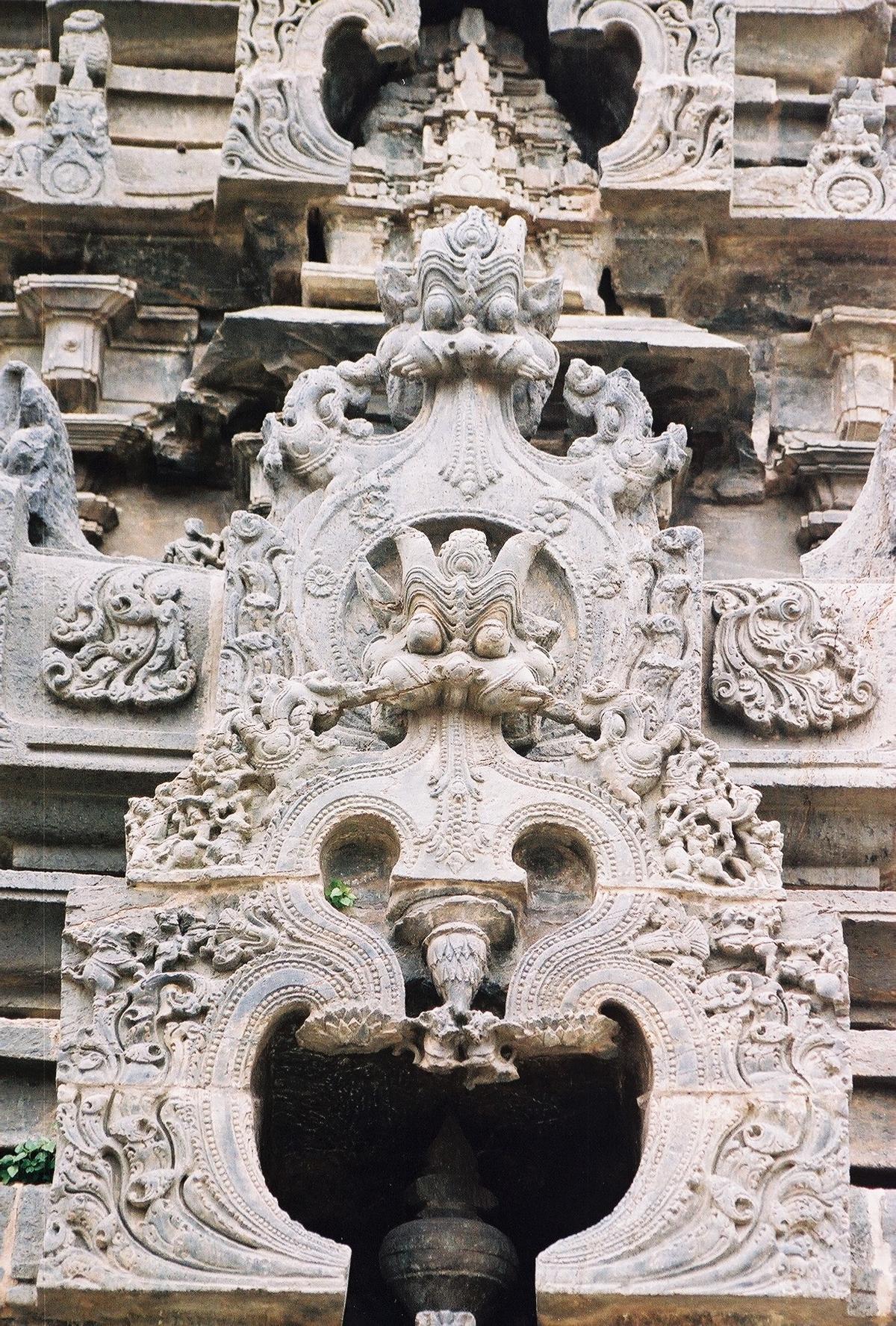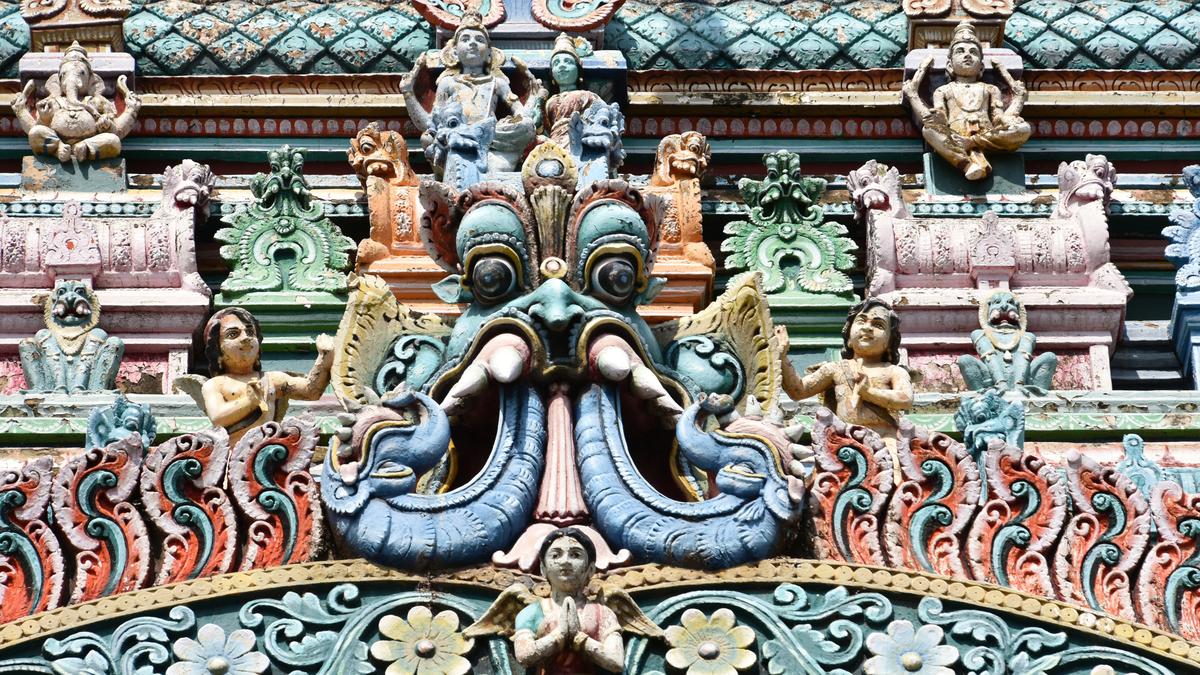On the top of many Hindu temples, one finds the image of a head looking down on the people below — his eyes protruding from its sockets, his mouth wide open, his tongue out. This is called the Kirtimukha, the Head of Glory, or Vajramukha, the Eternal Head.
There are many stories to explain its origins. The most popular is that of a goblin who was created by Shiva to kill demons. But when the demons apologised, Shiva forgave them. Now, the goblin was hungry and asked the lord for food. Shiva said, “Why don’t you eat your own body?” The creature began eating his hands, legs, and body, until there was nothing left. Impressed by his obedience, Shiva declared that his head would be placed on top of all temples, a symbol of insatiable hunger, devotion, and how useless the head is without the body — a counterpoint to when Brahmins claim they rose from the head of the Vedic Purusha, the primal man.
There are other stories of this head. In goddess temples of North India, one finds the image of Bhairava (a fierce form of Shiva) holding in his hand the head of Brahma. It is said that at the dawn of time, the deity had four heads facing the four directions. But then he saw the goddess Shatarupa (the multi-formed one, the first woman) and grew a fifth head on top, expressing his desire for her. Disgusted by this, the goddess called upon Rudra to protect her, and thus Bhairava was born. He chopped off Brahma’s fifth head, and he still holds it in his hand. According to some lore, this head can be detached only when he goes to the city of Kashi and washes his hand in the Ganga.
Beheading sons and fathers
In Shiva temples, one finds the image of Veerabhadra holding a head in one hand. This is the head of Daksha Prajapati, who neither understood nor recognised the greatness of the lord, leading Veerabhadra, a terrifying creature born of Shiva’s hair, to behead him.
Daksha was also the father-in-law of Shiva — the one whose daughter, Sati, chooses the lord as her husband against her father’s wishes. But tensions between her father and her husband lead to Sati taking her own life, angering Shiva, who, in the form of Veerabhadra, beheads his father-in-law. It is the head of the man who realised the power of Shiva when he lost control over his own body, the source of his own prejudices.

Kirtimukha relief at Amrutesvara Temple in Annigeri
Folk versions of the Mahabharata speak of a great warrior (known as Bilalsen in Nepal) who had taken a vow to always fight for the losing side. He was extremely strong. Krishna feared that such a person, who would keep switching sides, would prevent any war from coming to an end — especially the war being fought at Kurukshetra between the Pandavas and the Kauravas. So, Krishna asked the warrior to give him his head in alms. The warrior, who never refused requests of charity, cut off his own head and gave it to Krishna on the condition that it would be kept alive and allowed to witness the Mahabharata war.
In Rajasthan, this warrior is called Barbarik and is considered the grandson of Bhima, the son of Ghatotkacha by a Naga princess. The same story is told in other parts of India, such as Andhra Pradesh, Odisha, Malwa, Bundelkhand, Garhwal, and Himachal, where he is considered to be Bilalsen, the son of Bhima. His head was placed on top of a mountain, and every time it laughed, it produced such force that the armies of the Kauravas and the Pandavas were pushed in opposite directions, unable to fight. So the head was brought down and placed on the ground by Krishna.
When Krishna wept like a widow
Another such head appears in South India — in the story of Aravana, Arjuna’s son by the Naga princess Ulupi. Aravana was an extremely strong warrior who was sacrificed on the eve of the Mahabharata war. He did not want to die a virgin and begged to be given a wife before his sacrifice. Since no woman wanted to marry him, Krishna took the form of a woman, married him for the night, enabling his sacrifice at dawn. For him, Krishna wept like a widow.
Aravana’s head was also placed on top of a tree so that he could witness the war. While everyone believes the Mahabharata to be a war between the Pandavas and the Kauravas, Aravana realises that it is actually a war orchestrated by Krishna so that the blood of kings can quench the thirst of the Earth goddess, who is exhausted by their ambition and greed.
The head atop the temple thus forces temple devotees to look at life from a different perspective. Everything is not about us.
Devdutt Pattanaik is the author of 50 books on mythology, art and culture.
Published – August 16, 2025 11:37 am IST
